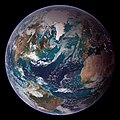Vaizdas:Blue Marble Western Hemisphere.jpg

Šios peržiūros dydis: 600 × 600 taškų. Kitos 6 rezoliucijos: 240 × 240 taškų | 480 × 480 taškų | 768 × 768 taškų | 1 024 × 1 024 taškų | 2 048 × 2 048 taškų | 3 718 × 3 718 taškų.
Didesnės raiškos iliustracija (3 718 × 3 718 taškų, rinkmenos dydis: 2,65 MiB, MIME tipas: image/jpeg)
Rinkmenos istorija
Paspauskite ant datos/laiko, kad pamatytumėte rinkmeną tokią, kokia ji buvo tuo metu.
| Data/Laikas | Miniatiūra | Matmenys | Naudotojas | Paaiškinimas | |
|---|---|---|---|---|---|
| dabartinis | 14:59, 5 kovo 2013 |  | 3 718 × 3 718 (2,65 MiB) | Szczureq | User created page with UploadWizard |
Paveikslėlio naudojimas
Paveikslėlis yra naudojamas šiuose puslapiuose:
Visuotinis rinkmenos naudojimas
Ši rinkmena naudojama šiose viki svetainėse:
- Naudojama alt.wikipedia.org
- Naudojama av.wikipedia.org
- Naudojama bn.wikipedia.org
- Naudojama ca.wikipedia.org
- Naudojama ckb.wikipedia.org
- Naudojama cv.wikipedia.org
- Naudojama da.wikipedia.org
- Naudojama el.wikipedia.org
- Naudojama en.wikipedia.org
- Ecological footprint
- User:P3Y229/sandbox
- Wikipedia:Meetup/NYC/AfroCrowd/Home
- Wikipedia:Wikipedia Signpost/2018-10-28/Gallery
- Wikipedia:Wikipedia Signpost/Single/2018-10-28
- User:Lngnbchr/TWA/Earth/2
- User:Saoirse mck/TWA/Earth/2
- User:Northamerica1000/Topics
- User:Nikola Tesla edit/TWA/Earth/2
- User:SDL87/TWA/Earth/2
- User:Mpurcell1/TWA/Earth/2
- User:Mpbrooke/TWA/Earth/2
- User:Tlonedyr
- User:JD Cornbread/TWA/Earth/2
- Naudojama en.wikibooks.org
- Naudojama en.wikiquote.org
- Naudojama en.wiktionary.org
- Naudojama es.wikipedia.org
- Naudojama eu.wikipedia.org
- Naudojama fa.wikipedia.org
- Naudojama fi.wikipedia.org
- Naudojama fr.wikipedia.org
- Naudojama he.wikipedia.org
- Naudojama hu.wikipedia.org
- Naudojama hy.wikipedia.org
- Naudojama id.wikipedia.org
- Naudojama it.wiktionary.org
- Naudojama ja.wikipedia.org
- Naudojama kk.wikipedia.org
- Naudojama ko.wikipedia.org
Žiūrėti visuotinį šios rinkmenos naudojimą.



